British black-and-white fantasies
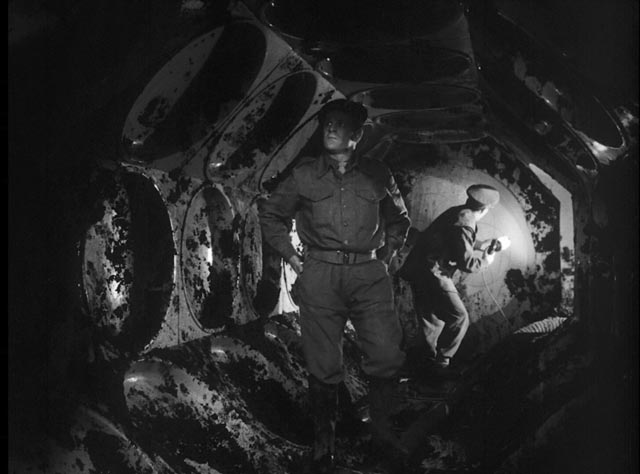
Once again, coincidence gives the illusion of meaning to my viewing choices. Last week I wrote here about three black-and-white movies by English directors which I’d recently watched on Blu-ray. And here I am with two more, though both less mainstream than Alfred Hitchcock’s Notorious, John Guillermin’s Town on Trial and Wolf Rilla’s Village of the Damned.
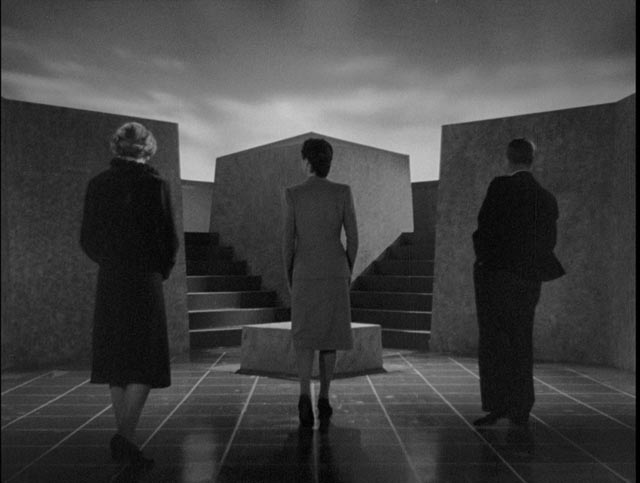
They Came to a City (Basil Dearden, 1944)
Ealing Studios is still today best known for the very English comedies they produced in the late 1940s and ’50s, some of which are masterpieces (Robert Hamer’s Kind Hearts and Coronets, Alexander Mackendrick’s The Man in the White Suit and The Ladykillers, Charles Crichton’s The Lavender Hill Mob), while some now seem pokey and provincial (Crichton’s The Titfield Thunderbolt, Henry Cornelius’ Passport to Pimlico). But in that same period, they also made potent dramas (and melodramas) like Hamer’s Pink String and Sealing Wax and It Always Rains on Sunday, Mackendrick’s Mandy and Thorold Dickinson’s Secret People; and films dealing with crime and social issues – Basil Dearden’s The Blue Lamp and Pool of London, Charles Frend’s The Long Arm and Seth Holt’s Nowhere to Go.
But before that run, the studio had produced quite a few, often surprisingly dark, propaganda films during the war – Dickinson’s Next of Kin, Cavalcanti’s Went the Day Well?, Dearden’s The Bells Go Down. Less rousing than Hollywood’s propaganda, which saw the war as something at a distance (and as often as not, as an adventure and opportunity for heroism), these films reflected the sense of imminent threat on the home front. They had an urgency which suggested that the war could still be lost if the population at large faltered in their resolve to resist Germany’s attacks.
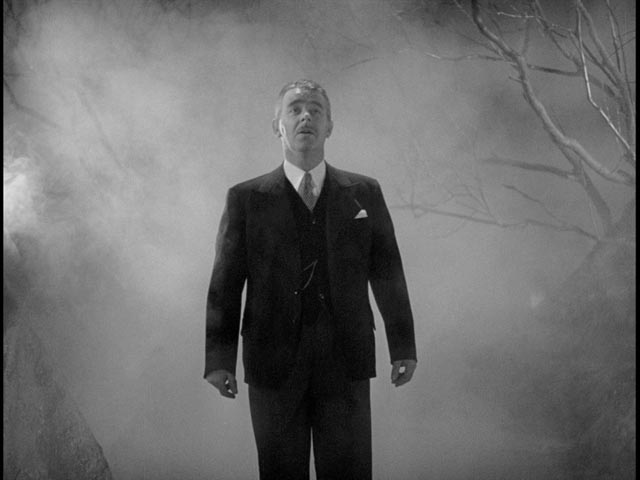
But after D-Day, when it seemed clear that Germany was headed for defeat, Ealing produced an odd film which looked forward to a postwar world which seemed open to remaking after years of destruction. They Came to a City (1944) was directed by Dearden, adapted by him, producer Sidney Cole and writer J.B. Priestley from Priestley’s own stage play. The film remains a theatrical experience, largely because the text itself is deliberately symbolic, making no attempt at any kind of naturalistic drama. Rather, it’s Priestley’s attempt to make a philosophical argument for a socialist transformation of society, the war providing an opportunity to rethink how people can live together rather than being bound by class and economic divisions. Not surprisingly, it’s a tough idea to visualize and the film remains bound by the didactic dialogue of its nine characters as they expose their fears, insecurities, selfishness and idealism.
In a prologue, Priestley himself encounters a young couple in uniform arguing on a hillside about what the future will be like after the war. He sits down beside them and begins to spin a hypothetical tale. We’re introduced through brief vignettes to nine different people, each representative of a particular social/psychological type, and each of whom walks out of the scene into a pitch black night only to emerge in an unfamiliar, mist-shrouded wood. One by one they make their way to a huge stone edifice resembling castle ramparts (somewhat reminiscent of the castle set in Laurence Olivier’s Hamlet, made four years later); and as they meet, they gradually reveal themselves to each other – an aggressive businessman, Mr. Cudworth (Norman Shelley), who’s consumed by making money for its own sake; Malcolm Stritton (Raymond Huntley), a middle-class bank employee, and his wife (Renee Gadd), a woman crippled by insecurity; Sir George Gedney (A.E. Matthews), a creaky remnant of the moribund aristocracy, and Lady Loxfield (Mabel Terry-Lewis), a woman absolutely convinced of her own entitlement, while her daughter Philippa (Frances Rowe) chafes at being controlled by her mother’s demands; and Mrs. Barley (Ada Reeve), a weary charwoman who spends her life scrubbing the floors that others walk on without even noticing her – all she really wants is to be able to rest, but she remains cheerful and open-hearted.
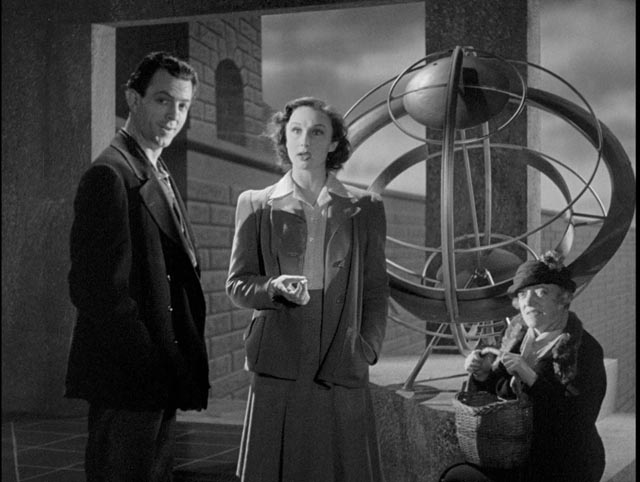
Then there is Joe Dinmore (John Clements), a seaman who has seen degradation and hardship all over the world and also seen that the individual has little power to change the status quo; he’s close to becoming a bitter cynic. Set against him is Alice (Googie Withers), a waitress and barmaid who has just ditched yet another job in which she’s been abused, and yet who believes there must be something better somewhere.
As these characters bounce off each other on the high castle walls, one of them peers into the abyss below and glimpses through the mist a great city (which, given the budgetary limitations, we have to take their word for). There’s a great door in the tower above them which seems impenetrable, but at a certain point, as they argue their differing values and beliefs, the door swings open onto a stone stairway which leads down to the city below. Uncertain, suspicious, even fearful, most of them hesitate, but eventually all pass through the door and disappear. This is essentially the end of act one and we cut back to Priestley and the couple on the hillside for a brief interlude before he resumes his story.
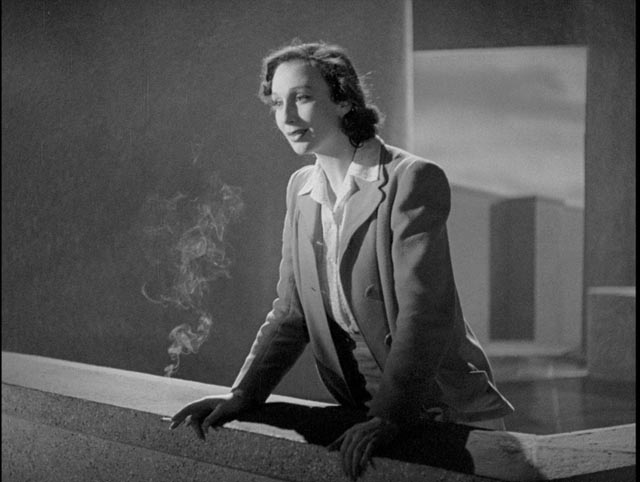
In act two, the characters begin to wander back up and out through the door and they speak of what they’ve seen and how they feel about it. They’ve had a vision of a Utopian society in which everyone is free and everyone supports everyone else, a place devoid of petty egotism and conflicts. Sir George and Lady Loxfield are appalled because there is no place for their personal privilege in this city; it means the end of everything which defines them. Mr. Cudworth is equally appalled because the city provides no opportunities for competition and the accumulation of wealth. Philippa on the other hand sees an opportunity to become herself, to serve something larger than her mother’s needs, while Mrs. Barley sees a refuge where she can finally rest her weary bones.
None of these responses are surprising given what we’ve previously learned of these characters. The biggest change has happened to Mr. Stritton, a man who has worked inside the financial system and seen it for the unfair and corrupt business it is; he believes in change, in opening up opportunities to those who have been excluded … but his wife remains terrified of change, clinging to him and what she believes is some kind of security. Given the choice of remaining with her or forging ahead into this new society, he chooses her – but it’s a choice which leaves open the possibility that he might seek something different because he now knows the status quo is not inevitable.
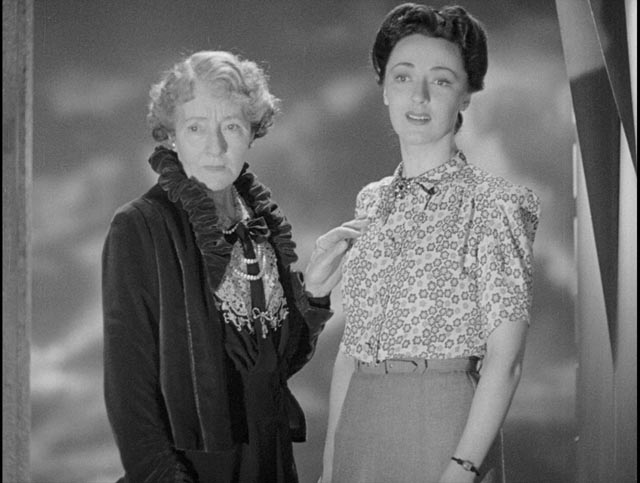
Finally, Joe emerges from below, still seeming bitter and conflicted. What he has seen seems to be the ideal he has lost faith in and it’s almost as if he resents having been shown it. As the door begins to swing shut again, closing off access to this ideal world, Alice hurries back up the stairs and slips out just before it closes for good. She’s angry at Joe, having also seen a world she wants to live in, one which the feelings she has developed for him have caused her to lose. But he argues that for them to both retreat into the city, a place already perfect, would be shirking a larger responsibility. Rather, knowing what they now know, it’s up to them to return to the imperfect world and fight to create something better, something they now know can be made real …
The film’s weaknesses should be clear from this description. It isn’t drama, but rather an argument embodied by predictable stereotypes. And yet, Michael Relph’s (very theatrical) design is visually striking and the cast manages to infuse those types with a degree of life and personality which rises above their schematic conception. While the argument lasts, the non-stop conversations are engaging because the performances possess genuine charm. However, when it’s all over, one can’t help but be aware that Priestley has been unable to crack the central problem of how to convincingly portray Utopia. Not only is the ideal city left un-visualized; the characters’ verbal descriptions remain vague to a degree which is all but meaningless … making it a less than convincing model for rebuilding the real world as it emerges from years of war.
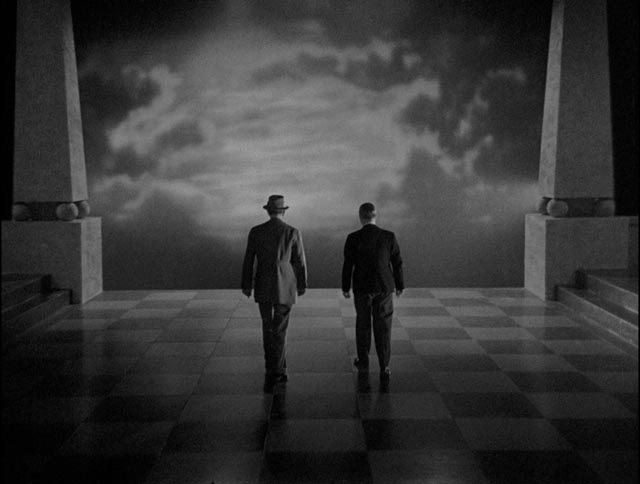
You’re left feeling that Priestley and Dearden’s hearts are in the right place, but they really haven’t given even a glimpse of a practical program for social transformation. Which needless to say, given that the film is nothing more than a didactic argument for that transformation, is a serious shortcoming.
And yet the film does have real pleasures – its design, the performances – and even the flow and rhythm of the dialogue, so recognizable as Priestley’s work. I was constantly reminded of James Whale’s The Old Dark House, based on Priestley’s novel Benighted, which is full of similar conversations reflecting class conflicts … yet rendered as wickedly amusing banter rather than as didactic argument.
The print of They Came to a City shows some slight damage, with light scratches and flecks of dirt, but overall displays some nice contrast and detail, with a pleasant degree of film grain. The soundtrack, very clean, is mostly dialogue, with some music (Scriabin’s Symphony No. 3 op. 43).
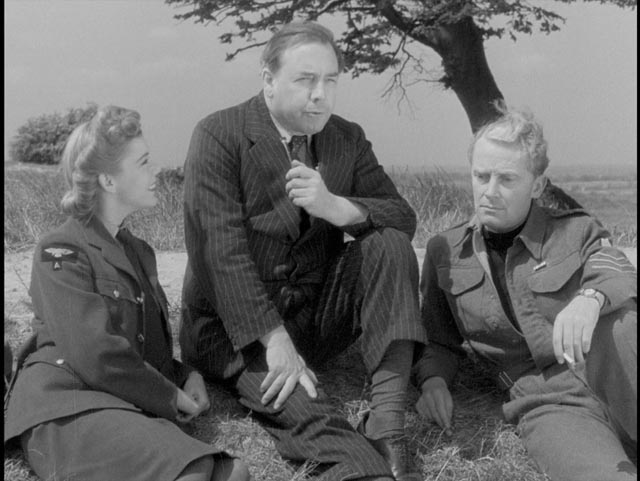
Extras include an audio interview with producer Michael Balcon, head of Ealing Studios from 1938 to 1955, covering his career.
There are also five short films relevant to the issues raised in the feature. Cavalcanti’s We Live in Two Worlds (1937, 13:52) is essentially an illustrated lecture by Priestley offering an internationalist vision to counter the rising nationalism and militarization of Europe in the late ’30s. Produced by John Grierson, it contains some interesting imagery of life in Switzerland, occasionally cut in the Soviet montage style. Harry Watt’s Britain at Bay (1940, 7:06) is a propaganda piece using stock footage – idyllic and vibrant images of England juxtaposed with war footage – held together by a patriotic narration from Priestley, all designed to raise morale for the on-going fight. John Eldridge’s A City Reborn (1945, 22:22), written by Dylan Thomas, combines documentary footage and staged scenes to describe plans to rebuild and modernize Coventry, a city devastated by bombing during the war. Charley in New Town (8:33) and Your Very Good Health (8:58), both made in 1948, are animations by John Halas and Joy Batchelor promoting post-war reconstruction – redesigning towns more humanely in the first, creating the National Health Service in the second.
*
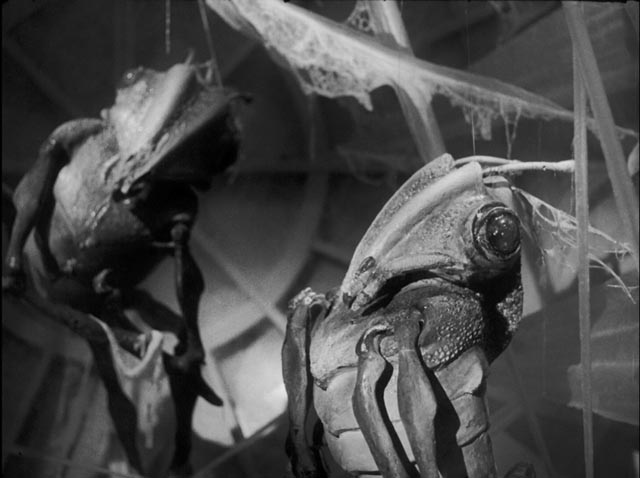
Quatermass and the Pit (Rudolph Cartier, 1959)
Fantasy is used in a very different way to address large themes in Nigel Kneale’s third Quatermass serial, produced in six episodes for the BBC by Rudolph Cartier between December 1958 and January 1959. Kneale’s work had been growing steadily more complex and sophisticated since the original Quatermass Experiment had aired on the BBC in 1953. That serial was a very well-constructed monster story in which the first man to return from a space flight is contaminated by alien spores which gradually transform him into a protoplasmic blob which absorbs any living tissues it touches. The second serial, Quatermass II (1953), was about a deliberate invasion by aliens which have the power to take over human beings and control them.
The third serial, Quatermass and the Pit, adds more thematic layers, incorporating the history of human evolution, superstition and religion into a story of alien invasion-by-proxy. Excavation for a new section of the London Underground uncovers several fossilized skeletons of previously unknown proto-humans – apelike creatures with large skulls indicating brains more highly developed than anything previously discovered. Further investigation reveals what appears to be a crashed spaceship dating back millions of years. Made from a material not known to science, the ship embodies a kind of sentient energy which affects many of the people who come near it with feelings of terror and violence.
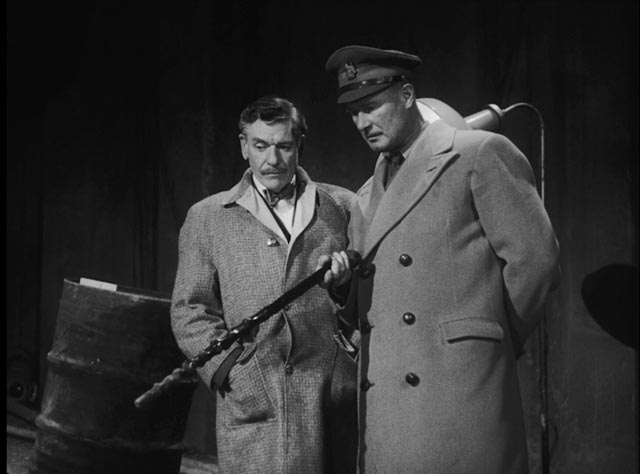
Quatermass (Andre Morrell) and his friend Roney (Cec Linder), the paleontologist investigating the find, come to the conclusion that the ship came from Mars, that the insect-like Martians knew that their world was dying and, although Earth was unsuited for their habitation, they attempted to perpetuate their civilization by taking primitive simians and genetically modifying them before returning them to Earth. The ship under London was one of many, this one having crashed, killing everything aboard. In essence, the human species was created by alien insects who vicariously took over this planet through them.
The problem was that the Martians imbued their creation with their own limitations – a highly structured, stratified society with no tolerance for difference. Hence the human penchant for competition, conflict, war and genocide. The influence of the Martians is played out in contemporary social and political conflicts and the various reactions of characters to the discovery. At the serial’s start, Quatermass is fighting against a bureaucracy which is determined to turn his scientific research into a means to create world-dominating weaponry. His British Rocket Group is to be put into the hands of Colonel Breen (Anthony Bushell), a man who sees everything in binary terms of us and them. As the power of the ship spreads, Breen becomes more and more paranoid, while the more self-aware Quatermass fights the urges being forced on him, trying to assert a human independence against the evolutionary control of the Martians.
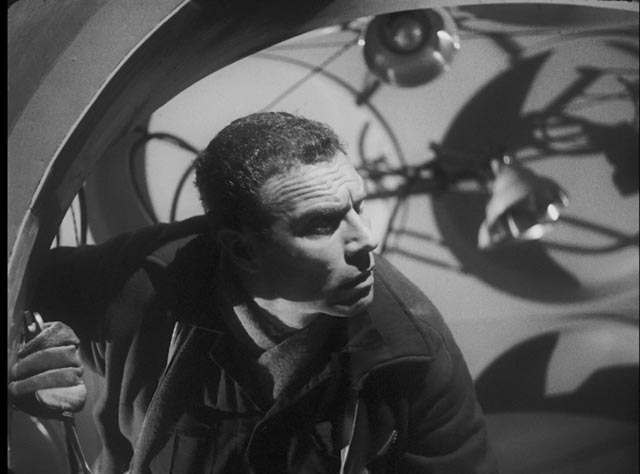
Woven through Kneale’s script is a biological/evolutionary explanation of political conflict along with the darker origins of religious belief in supernatural forces, ghosts and demons. The story is worked out with intellectual rigour, and embodied in a tense, suspenseful narrative which moves at a rapid pace through its levels of discovery, character conflicts both internal and external, and resolves in an apocalyptic struggle between regressive and progressive impulses within each character.
What’s remarkable is that this was all achieved with the limited means of production available to the filmmakers at the time.
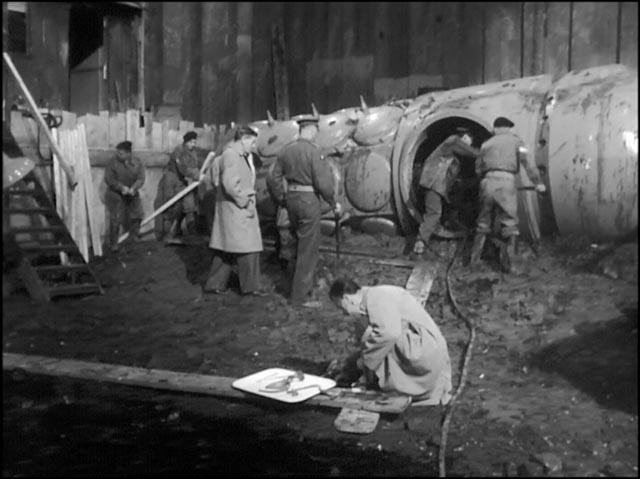
When I discovered that the serial was being released on Blu-ray by the BBC, I was slightly puzzled. Quatermass and the Pit, like its predecessors, had been broadcast live (with filmed inserts for exteriors), and recorded on film from monitors during the broadcast to create a copy for possible rebroadcast – the standard practice in the ’50s in England and the United States, known as Kinescopes. But according to the notes accompanying the disk, it wasn’t as simple as that. Parts of the show were rerecorded after the broadcast to correct technical flaws and tighten up the action, and much more of it was shot on film than I’d previously realized. I first saw the serial years ago on a PAL VHS tape which made the whole thing look quite murky, but I should have realized from the 2005 BBC DVD edition of all three serials that it wasn’t a straight Kinescope. Much of the camerawork in the pit set seems too elaborate to have been shot with multiple bulky video cameras – there are elaborate moves (including crane shots) and film-like cutting among multiple angles. But beyond that, a lot of the picture is too sharp to have been shot from a video monitor.
For the Blu-ray, the BBC went back to all the available elements, including fine-grain 35mm film, and rescanned everything in high definition. The results are impressive, with much of the disk displaying cinematic quality imagery; even the sections originally recorded from monitors, while softer, display quite impressive amounts of detail and contrast. The 2005 DVD was very watchable, but the Blu-ray is much more than that; this is not a studio-bound production, but rather an intelligent science fiction movie as good as anything made theatrically in that decade, and far better than most thanks to Kneale’s superb writing, Cartier’s direction, Clifford Hatts’ excellent production design, and a terrific cast who take their roles seriously, fully committed to the material.
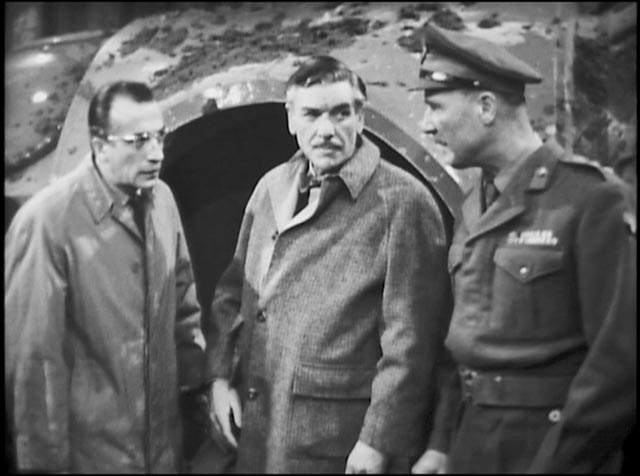
Extras include alternate title sequences from the BBC archive (7:46), a brief featurette about the visual effects (7:08), an extensive gallery of behind the scenes photos … and commentaries put together by Quatermass authority Toby Hadoke incorporating new and archival interviews with members of the cast and crew which span the entire 3:24:00 running time. It’s a great package which makes the serial even more impressive than it already seemed.
Comments
I’m quite a fan of the Quatermass serials and films but I’m not sure I’ll buy that at this point. I have so many things in front of it clamoring for my dollars. I’m just finishing up filling in the last of the Doctor Who series so that could free up a bit of spare money to buy other things.
Mind you my Amazon UK Wishlist is massive and I just added about a dozen Brit movies I hadn’t seen before. I ordered one yesterday, a romantic comedy called Who Goes There! with Valerie Hobson and Nigel Patrick. I don’t know anything about it other than it was written by John Dighton who also wrote Kind Hearts And Coronets and Roman Holiday. Could be good.
The other titles on my Wishlist are Nothing Barred; Don’t Just Lie There, Say Something; In The Doghouse; You Must Be Joking!; The Amorous Prawn; Operation Bullshine; Mister Ten Per Cent; Bottoms Up!; The Cracksman; Sands of The Desert; His and Hers; The House Across the Lake; The Strange Awakening; and The March Hare. Not sure if any are any good but I’ll add one to an occasional TV show order and take a chance. Most of them are pretty cheap, £2-6, so I won’t be wasting that much money. Especially if the exchange is favorable to me as it has been lately.
When it comes to Doctor Who, I’m a purist. William Hartnell is the one and only genuine Doctor. Before emigrating to Canada in 1966, I watched every episode beginning with number one.
There was actually a lot of good fantasy/sci-fi programming on English TV in the ’60s and ’70s: Adam Adamant (some of Ridley Scott’s earliest work), A for Andromeda, Doomwatch, Strange Report, Timeslip, Sapphire and Steel, Survivors … a lot of it still holds up despite production limitations. Brit TV has always benefited from very good writers.
I remember seeing Doctor Who back in Winnipeg. I recently read, 3-4 years ago, that only the first series of Doctor Who aired in Canada. I haven’t confirmed that but I have seen it mentioned more than once on Doctor Who sites and in the DVD extras. I don’t remember seeing it again until after I had moved to the US, in the 80s when PBS aired them. I didn’t actually get into it then.
When I watched nearly the whole 25 years of the first run I found I liked something about most of the Doctors. Not too say some of them aren’t annoying at times. I’ve only seen a few random episodes from the second run through but I have them to watch when I get a minute.
One of the things I liked about watching a serial each Sunday was I had set aside the time to watch the whole serial and then all the commentaries and making of materials. There’s a commentary for each episode and the making of featurettes were often more than an hour. They would have actors and crew, often 3 or 4 per episode, the conversation was lively, everyone had a story to tell and time to tell it. Sometimes there were 1-2 hours more stuff on a second disc. Yay to the BBC for that! No show has ever gotten such a through treatment. I think that really immersed me into the show and it added a lot to the enjoyment of watching it.
I guess I would have rather the show continued on, as opposed to ending it when poor William couldn’t really do the job anymore. If you haven’t seen David Bradley playing William in An Adventure In Space And Time I’d highly recommend it. Bradley is really good but that’s the sort of thing I’ve come to expect of him.
I’ve seen Adam Adamant and thought it would be nice to see good copies of it. I did see Sapphire and Steel and would easily exchange that show any one of the missing Doctor Who episodes. What a dull ass show. I didn’t care for characters and I could barely get to the end of the series. Maybe I didn’t, there’s a hole in my mind from that one. Worse than Blake7 which I thought was pretty sad. I cheered when they shot Blake but I thought he was a bit of a prick. No matter, there’s plenty of other good SF to watch.
I did like Adventure in Time and Space, though I thought Bradley leaned a little too hard on the cranky/confused side of Hartnell and didn’t quite catch his humour. It’s an excellent performance though.
I really liked Sapphire and Steel, found the stories very creepy in an old-fashioned ghost story way. But I’ve never seen Blake’s 7 … as you say, there’s plenty of good stuff to watch …